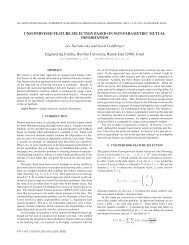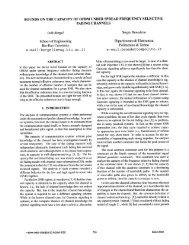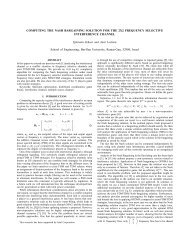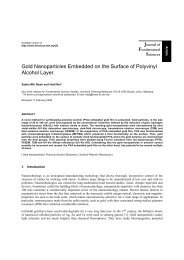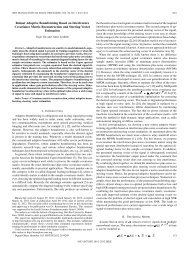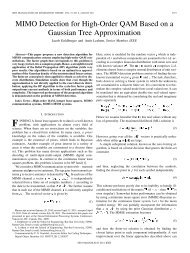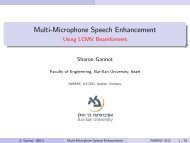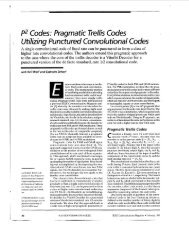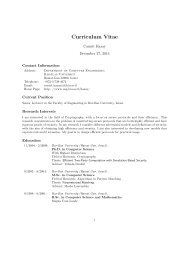Microfluidic single-cell real-time PCR for comparative analysis of ...
Microfluidic single-cell real-time PCR for comparative analysis of ...
Microfluidic single-cell real-time PCR for comparative analysis of ...
You also want an ePaper? Increase the reach of your titles
YUMPU automatically turns print PDFs into web optimized ePapers that Google loves.
protocolFigure 5 | Interpretation <strong>of</strong> heat map results.The heat map shows C Tvalues encoded bydifferent colors. Positive controls will showresults <strong>for</strong> all the studied genes, whereasnegative controls will not show any C Tvalue(encoded in black). Good samples will havehigh C Tvalues <strong>for</strong> the housekeeping gene,whereas a bad sample or chip run will notshow housekeeping gene C Tvalues or thesewill be contradictory. Among the goodsamples, there will be genes that are highlyexpressed compared with others that arebarely detected. It is also possible thatC Tvalues are not obtained <strong>for</strong> a specificgene, which can be interpreted as a lack <strong>of</strong>expression in this particular <strong>cell</strong> sample.Samples25 : S2526 : S2640 : S4032 : S3247 : S47Gene assays48 : A4847 : A4746 : A4645 : A4544 : A4443 : A4342 : A4241 : A4140 : A4039 : A3938 : A3837 : A3736 : A3635 : A3534 : A3433 : A3332 : A3231 : A3130 : A3029 : A2928 : A2827 : A2726 : A2625 : A2524 : A2423 : A2322 : A2221 : A2120 : A2019 : A1918 : A1817 : A1716 : A1615 : A1514 : A1413 : A1312 : A1211 : A1110 : A1009 : A0908 : A0807 : A0706 : A0605 : A0504 : A0403 : A0302 : A0201 : A01Housekeeping genein triplicatePositive controlNegative controlBad sample OR Chip runSample with C T values <strong>for</strong> all the genesSample with some undertermined genesUndeterminedgeneHighgene expressionVery lowgene expression© 2012 Nature America, Inc. All rights reserved.Acknowledgments We are grateful to P.E. de Almeida <strong>for</strong> FACS discussion.We acknowledge funding support from the Swiss National Science FoundationPBBEP3_129803 (V.S.-F.); the German Research Foundation (A.D.E.); the HowardHughes Medical Institute (S.R.Q.); the US National Institutes <strong>of</strong> Health (NIH)DP2OD004437, RC1AG036142, R01AI085575 (J.C.W.), and the Burroughs WellcomeFoundation (J.C.W.).AUTHOR CONTRIBUTIONS V.S.-F. and A.D.E. prepared most <strong>of</strong> the paper. T.K.,S.R.Q. and J.C.W. provided advice and pro<strong>of</strong>read the paper.COMPETING FINANCIAL INTERESTS The authors declare competing financialinterests: details accompany the full-text HTML version <strong>of</strong> the paper at http://www.natureprotocols.com/.Published online at http://www.natureprotocols.com/.Reprints and permissions in<strong>for</strong>mation is available online at http://www.nature.com/reprints/index.html.1. Kalisky, T. & Quake, S.R. Single-<strong>cell</strong> genomics. Nat. Methods 8, 311–314(2011).2. Heid, C.A., Stevens, J., Livak, K.J. & Williams, P.M. Real <strong>time</strong> quantitative<strong>PCR</strong>. Genome Res. 6, 986–994 (1996).3. Harris, T.D. et al. Single-molecule DNA sequencing <strong>of</strong> a viral genome.Science 320, 106–109 (2008).4. Kurimoto, K., Yabuta, Y., Ohinata, Y. & Saitou, M. Global <strong>single</strong>-<strong>cell</strong> cDNAamplification to provide a template <strong>for</strong> representative high-densityoligonucleotide microarray <strong>analysis</strong>. Nat. Protoc. 2, 739–752 (2007).5. Flatz, L. et al. Single-<strong>cell</strong> gene-expression pr<strong>of</strong>iling reveals qualitativelydistinct CD8 T <strong>cell</strong>s elicited by different gene-based vaccines. Proc. Natl.Acad. Sci. USA 108, 5724–5729 (2011).6. Guo, G. et al. Resolution <strong>of</strong> <strong>cell</strong> fate decisions revealed by <strong>single</strong>-<strong>cell</strong>gene expression <strong>analysis</strong> from zygote to blastocyst. Dev. Cell 18, 675–685(2010).7. Shi, X. et al. Real-<strong>time</strong> <strong>PCR</strong> <strong>of</strong> <strong>single</strong> bacterial <strong>cell</strong>s on an array <strong>of</strong>adhering droplets. Lab Chip 11, 2276–2281 (2011).8. Elowitz, M.B., Levine, A.J., Siggia, E.D. & Swain, P.S. Stochastic geneexpression in a <strong>single</strong> <strong>cell</strong>. Science 297, 1183–1186 (2002).9. Levsky, J.M. & Singer, R.H. Gene expression and the myth <strong>of</strong> the average <strong>cell</strong>.Trends Cell. Biol. 13, 4–6 (2003).10. Stahlberg, A. & Bengtsson, M. Single-<strong>cell</strong> gene expression pr<strong>of</strong>iling usingreverse transcription quantitative <strong>real</strong>-<strong>time</strong> <strong>PCR</strong>. Methods 50, 282–288 (2010).11. Rajan, S., Djambazian, H., Dang, H.C., Sladek, R. & Hudson, T.J. Theliving microarray: a high-throughput plat<strong>for</strong>m <strong>for</strong> measuring transcriptiondynamics in <strong>single</strong> <strong>cell</strong>s. BMC Genomics 12, 115 (2011).12. Zhang, Y., Zhu, Y., Yao, B. & Fang, Q. Nanolitre droplet array <strong>for</strong> <strong>real</strong>-<strong>time</strong>reverse transcription polymerase chain reaction. Lab Chip 11, 1545–1549(2011).13. Morris, J., Singh, J.M. & Eberwine, J.H. Transcriptome <strong>analysis</strong> <strong>of</strong> <strong>single</strong><strong>cell</strong>s. J. Vis. Exp. (2011).14. White, A.K. et al. High-throughput micr<strong>of</strong>luidic <strong>single</strong>-<strong>cell</strong> RT-q<strong>PCR</strong>.Proc. Natl. Acad. Sci. USA 108, 13999–14004 (2011).15. Narsinh, K.H. et al. Single <strong>cell</strong> transcriptional pr<strong>of</strong>iling revealsheterogeneity <strong>of</strong> human induced pluripotent stem <strong>cell</strong>s. J. Clin. Invest. 121,1217–1221 (2011).16. Warren, L., Bryder, D., Weissman, I.L. & Quake, S.R. Transcription factorpr<strong>of</strong>iling in individual hematopoietic progenitors by digital RT-<strong>PCR</strong>.Proc. Natl. Acad. Sci. USA 103, 17807–17812 (2006).17. Takahashi, K. & Yamanaka, S. Induction <strong>of</strong> pluripotent stem <strong>cell</strong>s frommouse embryonic and adult fibroblast cultures by defined factors.Cell 126, 663–676 (2006).18. Schroeder, T. Long-term <strong>single</strong>-<strong>cell</strong> imaging <strong>of</strong> mammalian stem <strong>cell</strong>s.Nat. Methods 8, S30–S35 (2011).19. Hope, K. & Bhatia, M. Clonal interrogation <strong>of</strong> stem <strong>cell</strong>s. Nat. Methods 8,S36–S40 (2011).20. Spurgeon, S.L., Jones, R.C. & Ramakrishnan, R. High throughput geneexpression measurement with <strong>real</strong> <strong>time</strong> <strong>PCR</strong> in a micr<strong>of</strong>luidic dynamicarray. PLoS ONE 3, e1662 (2008).21. Mary, P. et al. Analysis <strong>of</strong> gene expression at the <strong>single</strong>-<strong>cell</strong> level usingmicrodroplet-based micr<strong>of</strong>luidic technology. Biomicr<strong>of</strong>luidics 5, 24109(2011).22. Tamburini, B.A. et al. Gene expression pr<strong>of</strong>iling identifies inflammationand angiogenesis as distinguishing features <strong>of</strong> canine hemangiosarcoma.BMC Cancer 10, 619 (2010).23. Stahlberg, A., Kubista, M. & Aman, P. Single-<strong>cell</strong> gene-expression pr<strong>of</strong>ilingand its potential diagnostic applications. Expert Rev. Mol. Diagn. 11,735–740 (2011).24. Al Dahouk, S., Tomaso, H., Nockler, K. & Neubauer, H. The detection <strong>of</strong>Bru<strong>cell</strong>a spp. using <strong>PCR</strong>-ELISA and <strong>real</strong>-<strong>time</strong> <strong>PCR</strong> assays. Clin. Lab 50,387–394 (2004).25. Simunovic, F., Yi, M., Wang, Y., Stephens, R. & Sonntag, K.C. Evidence <strong>for</strong>gender-specific transcriptional pr<strong>of</strong>iles <strong>of</strong> nigral dopamine neurons inParkinson disease. PLoS ONE 5, e8856 (2010).26. Lindstrom, S., Hammond, M., Brismar, H., Andersson-Svahn, H. &Ahmadian, A. <strong>PCR</strong> amplification and genetic <strong>analysis</strong> in a microwell <strong>cell</strong>culturing chip. Lab Chip 9, 3465–3471 (2009).27. Zeng, Y., Novak, R., Shuga, J., Smith, M.T. & Mathies, R.A. Highper<strong>for</strong>mance<strong>single</strong> <strong>cell</strong> genetic <strong>analysis</strong> using micr<strong>of</strong>luidic emulsiongenerator arrays. Anal. Chem. 82, 3183–3190 (2010).28. Chan, E.M. et al. Live <strong>cell</strong> imaging distinguishes bona fide human iPS<strong>cell</strong>s from partially reprogrammed <strong>cell</strong>s. Nat. Biotechnol. 27, 1033–1037(2009).29. Sun, N. et al. Feeder-free derivation <strong>of</strong> induced pluripotent stem <strong>cell</strong>sfrom adult human adipose stem <strong>cell</strong>s. Proc. Natl. Acad. Sci. USA 106,15720–15725 (2009).30. Liu, J., Hansen, C. & Quake, S.R. Solving the ‘world-to-chip’ interfaceproblem with a micr<strong>of</strong>luidic matrix. Anal. Chem. 75, 4718–4723(2003).31. Li, Z. et al. Functional and transcriptional characterization <strong>of</strong> humanembryonic stem <strong>cell</strong>-derived endothelial <strong>cell</strong>s <strong>for</strong> treatment <strong>of</strong> myocardialinfarction. PLoS ONE 4, e8443 (2009).32. Ludwig, T.E. et al. Derivation <strong>of</strong> human embryonic stem <strong>cell</strong>s in definedconditions. Nat. Biotechnol. 24, 185–187 (2006).838 | VOL.7 NO.5 | 2012 | nature protocols



